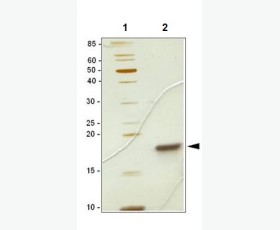Recombinant Human Ephrin-B1/EFNB1
| Product name: | Recombinant Human Ephrin-B1/EFNB1 |
| Source: | Human Cells |
| Purity: | Greater than 95% as determined by reducing SDS-PAGE. |
| Buffer Formulation: | Lyophilized from a 0.2 μm filtered solution of 20mM PB,150mM NaCl,pH7.4. |
| Applications: | Applications:SDS-PAGE; WB; ELISA; IP. |
| Storage: | Avoid repeated freeze/thaw cycles. Store at 2-8 oC for one month. Aliquot and store at -80 oC for 12 months. |
| UOM: | 100ug/50ug/200ug/1mg/1g |
| Source | Human Cells |
| Description | Recombinant Human Ephrin-B1 is produced by our Mammalian expression system and the target gene encoding Leu28-Gly232 is expressed with a 6His tag at the C-terminus. |
| Names | Ephrin-B1,EFL-3, ELK ligand, EPH-related receptor tyrosine kinase ligand 2,LERK-2 |
| Accession # | P98172 |
| Formulation | Lyophilized from a 0.2 μm filtered solution of 20mM PB,150mM NaCl,pH7.4. |
| Shipping |
The product is shipped at ambient temperature. |
| Reconstitution |
Always centrifuge tubes before opening. Do not mix by vortex or pipetting. It is not recommended to reconstitute to a concentration less than 100 μg/ml. Dissolve the lyophilized protein in ddH2O. Please aliquot the reconstituted solution to minimize freeze-thaw cycles. |
| Storage |
Lyophilized protein should be stored at < -20°C, though stable at room temperature for 3 weeks. Reconstituted protein solution can be stored at 4-7°C for 2-7 days. Aliquots of reconstituted samples are stable at < -20°C for 3 months. |
| Purity |
Greater than 95% as determined by reducing SDS-PAGE. |
| Endotoxin | Less than 0.1 ng/µg (1 IEU/µg) as determined by LAL test. |
| Amino Acid Sequence |
LAKNLEPVSWSSLNPKFLSGKGLVIYPKIGDKLDIICPRAEAGRPYEYYKLYLVRPEQAAACSTV LDPNVLVTCNRPEQEIRFTIKFQEFSPNYMGLEFKKHHDYYITSTSNGSLEGLENREGGVCRTRT MKIIMKVGQDPNAVTPEQLTTSRPSKEADNTVKMATQAPGSRGSLGDSDGKHETVNQEEKSGPGA SGGSSGDPDGVDHHHHHH
|
| Background | Ephrin-B1, also named EFL-3, ELK ligand, EPH-related receptor tyrosine kinase ligand 2, is a single-pass type I membrane protein. It contains 1 ephrin RBD (ephrin receptor-binding) domain and belongs to the ephrin family. Ephrins are divided into the ephrin-A (EFNA) class, which are anchored to the membrane by a glycosylphosphatidylinositol linkage, and the ephrin-B (EFNB) class, which are transmembrane proteins. All ephrins share a conserved extracellular sequence, which most likely corresponds to the receptor-binding domain. Ephrin-B1 has been shown to bind EphA3, EphB1, EphB2, EphB3, and EphB4. The extracellular domains of human and mouse ephrin-B1 share 94% amino acid identity. |














